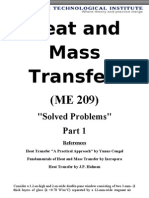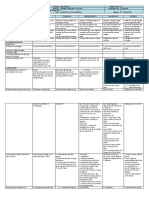0 ratings0% found this document useful (0 votes)
17 views5 Heat Transfer Autosaved
5 Heat Transfer Autosaved
Uploaded by
z5c6h6m9gjCopyright:
© All Rights Reserved
Available Formats
Download as PPTX, PDF, TXT or read online from Scribd
5 Heat Transfer Autosaved
5 Heat Transfer Autosaved
Uploaded by
z5c6h6m9gj0 ratings0% found this document useful (0 votes)
17 views30 pagesCopyright
© © All Rights Reserved
Available Formats
PPTX, PDF, TXT or read online from Scribd
Share this document
Did you find this document useful?
Is this content inappropriate?
Copyright:
© All Rights Reserved
Available Formats
Download as PPTX, PDF, TXT or read online from Scribd
Download as pptx, pdf, or txt
0 ratings0% found this document useful (0 votes)
17 views30 pages5 Heat Transfer Autosaved
5 Heat Transfer Autosaved
Uploaded by
z5c6h6m9gjCopyright:
© All Rights Reserved
Available Formats
Download as PPTX, PDF, TXT or read online from Scribd
Download as pptx, pdf, or txt
You are on page 1of 30
Heat
Transfer
WMSU Engr. Darry B. Junsay
Professional Mechanical Engineer
MEAN AREA CONCEPT
• When the area changes in the direction of flow, sometimes it is
convenient to use a mean area and use the heat equation applicable
to a slab i.e.
when this concept is applied to a cylinder
Example 2.13: A hollow cylinder of inner radius 0.16 m and
thickness 8 cm conducts heat radially. Determine the mean area
and check for the heat flow
PARALLEL FLOW
There are certain occasions where the barrier to heat flow is made up of several materials
in the same thickness as in a brick wall where bricks and mortar form the same layer. In
this case the heat flow is along parallel paths. (Fig. 2.11(a)) The assumption made here is
that temperature drop in each layer is the same. This is solved by using electrical analogy
as shown in Fig. 2.11(b), (c).
Example 2.14: Two slabs are placed in contact, but due to roughness, only 40% of
area is in contact and the gap in the remaining area is 0.02 mm thick and is filled
with air. The slabs are 10 cm thick each and their conductivities are 15.5 W/mK and
200 W/mK. The temperature of the face of the hot surface is at 250°C and the
outside surface of the other slab is at 35°C. Determine the heat flow and the
contact resistance. The conductivity of air is 0.0321 W/mK.
Solution: Of the contact area it is assumed that half of the contact is due to either metal. Total
area is taken as 1m². The equivalent circuit is given below (suffixes refer to the circuit)
CONDUCTION
WITH HEAT
GENERATION
INTRODUCTION
• In this chapter the additional factor of heat generation within the body is
to be considered.
• Heat generation is met with in electrical conductors carrying current. The
resistance heating has to be dissipated in such a way that the conductor
does not fail.
• The maximum temperature in the wire has to be limited. A more serious
case is the heat generation in nuclear reactor fuel rods.
• Here the generation rate is very high and accidents will be catastropic.
The heat generated has to be collected at the required rates at the
boundary to avoid failure.
• Microwave heating is another example. Exothermic reaction in chemical
processes also may cause problems if proper care is not taken to
maintain the temperature at or below the allowable level.
• The heat flow under steady conditions is easily estimated as the product
of the volume of the body and heat generation rate.
• The temperature drop through the body will increase with increased heat
generation. Higher thermal conductivity will lead to lower temperature
drop.
STEADY STATE ONE DIMENSIONAL CONDUCTION IN A
SLAB WITH UNIFORM HEAT GENERATION
The results of analysis are the same in both cases.
Example 3.1: Heat is generated in a slab of 120 mm thickness with
a conductivity of 200 W/ mK at a rate of W/m3. Determine the
temperature at the mid and quarter planes if the surface of the
solid on both sides are exposed to convection at 30°C with a
convection coefficient of 500 W/m2K. Also find the heat flow rate at
these planes and the temperature gradients at these planes.
The other boundary of interest is when the two
surfaces are maintained at different specified
temperatures as in
Example 3.2: In example 3.1, if the temperatures at the surfaces are maintained at
130°C and 150°C on the left and right sides determine the location and value of the
maximum temperature. Also find the heat flow on each side and the temperature at
the centre plane. q = W/m3, L = 0.06 m, k = 200 W/mK
STEADY STATE RADIAL HEAT CONDUCTION IN CYLINDER WITH
UNIFORM HEAT GENERATION. (FIG. 3.3)
Solid Cylinder: The boundary conditions are:
Example 3.3: A cylinder of 12 cm diameter has a heat generation rate W/m3. The
conductivity of the material is 200 W/mK. The surface is exposed to air at 30°C. The
convection coefficient is 500 W/m2K. Determine the temperatures at the center and
also at mid radius. Also determine the heat flow at the surface on unit area basis.
Calculate the temperature gradients at the mid radius and surface .
Hollow cylinder of radius Ri , Ro with Ti and To specified. The
boundary conditions are
Example 3.5: A hollow cylinder 6 cm ID and 12 cm OD has a heat
generation rate of 5 × W/m3. The inner surface is maintained at 380°C and
the outer surface at 360°C. The conductivity of the material is 30 W/mK.
Determine (i) the location and value of the maximum temperature (ii) the
fraction heat generated going to the inner surface.
Hollow cylinder with inner surface adiabatic: The boundary
conditions are:
RADIAL CONDUCTION IN SPHERE WITH UNIFORM HEAT
GENERATION (FIG. 3.4)
END
You might also like
- Che 252 PS1 SP24 1Document2 pagesChe 252 PS1 SP24 1Momen SamirNo ratings yet
- 0073529362holman 10th EdDocument15 pages0073529362holman 10th EdhanockaNo ratings yet
- CONDUCTION1PROBLEMSDocument2 pagesCONDUCTION1PROBLEMSVed ParulekarNo ratings yet
- Very ImportantDocument6 pagesVery Importantmonuaadi2003No ratings yet
- HMT Imp QuesDocument4 pagesHMT Imp QuesEmily BarrettNo ratings yet
- Tutorial 2-1Document4 pagesTutorial 2-1chandan rajNo ratings yet
- Updated ProblemsDocument3 pagesUpdated Problemsmahmoud koriemNo ratings yet
- Assignment 01Document2 pagesAssignment 01Adan SantiagoNo ratings yet
- Tutorial 1 (Question)Document4 pagesTutorial 1 (Question)Muhd IlyasNo ratings yet
- Sheet 2Document4 pagesSheet 2Yasmin RedaNo ratings yet
- HT Practice Problems PDFDocument2 pagesHT Practice Problems PDFChinnarao PulapaNo ratings yet
- HMTDocument2 pagesHMTRajaji BhagaNo ratings yet
- Sheet 3Document5 pagesSheet 3Yasmin RedaNo ratings yet
- Heat and Mass Transfer QuizDocument7 pagesHeat and Mass Transfer Quizdsathiya0% (1)
- Assignment 1 Steady State Heat Conduction 2Document2 pagesAssignment 1 Steady State Heat Conduction 2Fa CaNo ratings yet
- HMT Question PaperDocument1 pageHMT Question PaperSanjay GomastaNo ratings yet
- 1492Document15 pages1492_Anggyaa_No ratings yet
- Questions Transport Phenomenon PDFDocument5 pagesQuestions Transport Phenomenon PDFvinay13579No ratings yet
- Problems: Heat TransferDocument7 pagesProblems: Heat TransferKinna VnezhNo ratings yet
- 1,2,3 ProblemsDocument25 pages1,2,3 ProblemsWild BotNo ratings yet
- Assignment 1 HMTDocument7 pagesAssignment 1 HMTAnkit SharmaNo ratings yet
- Heat Transfer AssinmentDocument4 pagesHeat Transfer AssinmentbaruaoleNo ratings yet
- ConductionDocument159 pagesConductionNugi100% (1)
- Che 342 Practice Set I IDocument4 pagesChe 342 Practice Set I IDan McNo ratings yet
- Sheet Ch.1Document4 pagesSheet Ch.1Ahmed KingNo ratings yet
- Work Sheet 1 2022Document6 pagesWork Sheet 1 2022Fikadu GonfaNo ratings yet
- Heat Transfer - Sheet Two ConductionDocument4 pagesHeat Transfer - Sheet Two ConductionMichael EmadNo ratings yet
- 4th Sem.-ME 1251-HMTDocument18 pages4th Sem.-ME 1251-HMTPon ShanmugakumarNo ratings yet
- Sheet 1Document5 pagesSheet 1Yasmin RedaNo ratings yet
- Worksheet 1 HMTDocument5 pagesWorksheet 1 HMTmubarekjemal3279No ratings yet
- Sheet 1 - IntroductionDocument2 pagesSheet 1 - IntroductionfelopateermadNo ratings yet
- Module 4 ConductionDocument41 pagesModule 4 ConductionDHruvGananathNo ratings yet
- CFD Analysis On Solar Flat Plate CollectorDocument7 pagesCFD Analysis On Solar Flat Plate CollectorkalirajgurusamyNo ratings yet
- A Set of Solved Problems Convective CorrelationDocument9 pagesA Set of Solved Problems Convective Correlationnanak guruNo ratings yet
- AbccccdddddDocument26 pagesAbccccdddddMehmet Saner ŞenkalaycıNo ratings yet
- Heat & Mass Transfer UNIT-1 Question BankDocument4 pagesHeat & Mass Transfer UNIT-1 Question Banksaraa009No ratings yet
- ME5101 2020 Assignment 01Document2 pagesME5101 2020 Assignment 01palash_shrivastava6282058No ratings yet
- Assignment QB 2015Document3 pagesAssignment QB 2015RutvikLathiaNo ratings yet
- Sheet 4Document3 pagesSheet 4Yasmin RedaNo ratings yet
- AHMT 1st AssignmentDocument2 pagesAHMT 1st AssignmentcnjoyusNo ratings yet
- Unsteady Conduction 19 OctoberDocument27 pagesUnsteady Conduction 19 OctoberAli AshrafNo ratings yet
- Heat Transfer College SlidesDocument2 pagesHeat Transfer College SlidesVivaan Sharma100% (1)
- Tutorial - Conduction Heat TransferDocument3 pagesTutorial - Conduction Heat TransferDayanidiNo ratings yet
- 4.tutorial HMTDocument5 pages4.tutorial HMTdearsaswatNo ratings yet
- Assignment No 1 HTDocument4 pagesAssignment No 1 HTDhiraj DhimanNo ratings yet
- Tutorial Chapter 1 eDocument3 pagesTutorial Chapter 1 eRotten AppleNo ratings yet
- Tutorials On Heat TransferDocument5 pagesTutorials On Heat Transferbldfst121518No ratings yet
- Problem Set 4Document1 pageProblem Set 4Dniel Suarez RNo ratings yet
- Me6502 HEAT TRANSFER Q.BDocument16 pagesMe6502 HEAT TRANSFER Q.Bmanoj kumar GNo ratings yet
- MEEG 306 Tutorial Revised May 2019Document30 pagesMEEG 306 Tutorial Revised May 2019sagar100% (1)
- 1 - EML5152 HWK 3 Spring2021Document9 pages1 - EML5152 HWK 3 Spring2021Udaykiran KakumaniNo ratings yet
- HW 01Document2 pagesHW 01Potatoes123No ratings yet
- Tarea 3 CalorDocument3 pagesTarea 3 CalorLuis AngelNo ratings yet
- Heat Transfer Question BankDocument3 pagesHeat Transfer Question Bankmohammed hashimNo ratings yet
- Assignment-1 24251 SemDocument3 pagesAssignment-1 24251 SemTanmayNo ratings yet
- SRM University: Part - A Answer ALL Questions (10 X 2 20 Marks)Document2 pagesSRM University: Part - A Answer ALL Questions (10 X 2 20 Marks)Ruby SmithNo ratings yet
- Sagar Group of Institutes, Bhopal: Subject: Heat& Mass Transfer CODE: ME-6003 Unit-IDocument3 pagesSagar Group of Institutes, Bhopal: Subject: Heat& Mass Transfer CODE: ME-6003 Unit-IRiyasNo ratings yet
- Chn-201 Tutorial 2 - Autumn 16-17-1Document2 pagesChn-201 Tutorial 2 - Autumn 16-17-1Prashant RajNo ratings yet
- Info Iec60953-0 (Ed1.0) BDocument23 pagesInfo Iec60953-0 (Ed1.0) BAdil EL FARDAOUINo ratings yet
- BME Model Question PaperDocument2 pagesBME Model Question PaperKailas Sree ChandranNo ratings yet
- Heat and Mass Transfer: "Solved Problems"Document16 pagesHeat and Mass Transfer: "Solved Problems"qiritical99No ratings yet
- 6 Grade Weather and Climate - CTS by Brett WalkerDocument15 pages6 Grade Weather and Climate - CTS by Brett Walkerapi-204177151No ratings yet
- Drying Oven CatalogueDocument10 pagesDrying Oven CatalogueRaj KumarNo ratings yet
- Monday Tuesday Wednesday Thursday FridayDocument7 pagesMonday Tuesday Wednesday Thursday FridayMarissel0% (1)
- Lab 6Document4 pagesLab 6AhmedNo ratings yet
- C177 - Test Method For Steady-State Heat Flux Measurements & Thermal Transmission Properties by Means of The Guarded-Hot-Plate ApparatusDocument22 pagesC177 - Test Method For Steady-State Heat Flux Measurements & Thermal Transmission Properties by Means of The Guarded-Hot-Plate ApparatusLech Ray Gomez CordobaNo ratings yet
- 6 Processes of Ideal GasDocument14 pages6 Processes of Ideal GasCruz Salise100% (1)
- Magnetic RefrigerationDocument20 pagesMagnetic RefrigerationVineet DubeyNo ratings yet
- 1 s2.0 S0196890421011778 MainDocument12 pages1 s2.0 S0196890421011778 Mainganfu2976No ratings yet
- Degrees of Freedom Analysis in Process ControlDocument7 pagesDegrees of Freedom Analysis in Process Controlharkonen3147No ratings yet
- Matter in Our Surroundings - MCQ Questions (Class-9)Document9 pagesMatter in Our Surroundings - MCQ Questions (Class-9)listenofficial16No ratings yet
- Summary of Some Useful Equations: HYPERS301.x Hypersonics From Shock Waves To ScramjetsDocument28 pagesSummary of Some Useful Equations: HYPERS301.x Hypersonics From Shock Waves To ScramjetsShivam AgarwalNo ratings yet
- CSE 2021 2025 - SyllabusDocument170 pagesCSE 2021 2025 - SyllabusGAVASKAR SNo ratings yet
- Chem CttoDocument6 pagesChem CttotantiadohannahmarielleNo ratings yet
- Understanding The Working Principle of A Heat Pump UnitDocument8 pagesUnderstanding The Working Principle of A Heat Pump Unitriwajkarki57No ratings yet
- Cooling Tower Design Handbook PDF - 2Document20 pagesCooling Tower Design Handbook PDF - 2num0067No ratings yet
- Fire Modelling and Cooling of Storage Tanks in Case of Radiation From Large Pool FiresDocument9 pagesFire Modelling and Cooling of Storage Tanks in Case of Radiation From Large Pool FiresTorero02No ratings yet
- Cambridge IGCSE Physics 0625 - Unit 2 Thermal Physics Revision Igcse - PhysicsDocument11 pagesCambridge IGCSE Physics 0625 - Unit 2 Thermal Physics Revision Igcse - Physicscodingninja7953No ratings yet
- Draft Lab 3Document2 pagesDraft Lab 3HAZMIERA AMRISYA HASLANNo ratings yet
- Questions and Current UnderstandingDocument13 pagesQuestions and Current Understandingalireza aziziNo ratings yet
- Components of The Glycol Circulating SystemDocument3 pagesComponents of The Glycol Circulating SystemdndudcNo ratings yet
- Module 7 General Physics 1 q2Document11 pagesModule 7 General Physics 1 q2Freya SalorNo ratings yet
- Design and Experimental Analysis of An Efficient HVAC Sysyem On An Electric BusDocument12 pagesDesign and Experimental Analysis of An Efficient HVAC Sysyem On An Electric BusEmre EmlekNo ratings yet
- DehoffDocument11 pagesDehoffVictor Manuel Romero Herrera100% (4)
- Transport Properties of FoodDocument435 pagesTransport Properties of Foodharish_s_1315100% (4)
- 4.0 - Kinetic Theory - MCQSDocument21 pages4.0 - Kinetic Theory - MCQSMarshell JonesNo ratings yet
- List Ebook BKKMTKI Daerah IIDocument26 pagesList Ebook BKKMTKI Daerah IIIrvan Arfian MaulanaNo ratings yet
- EKC216-Process Heat Transfer 1617Document11 pagesEKC216-Process Heat Transfer 1617Saiful MunirNo ratings yet

























































































